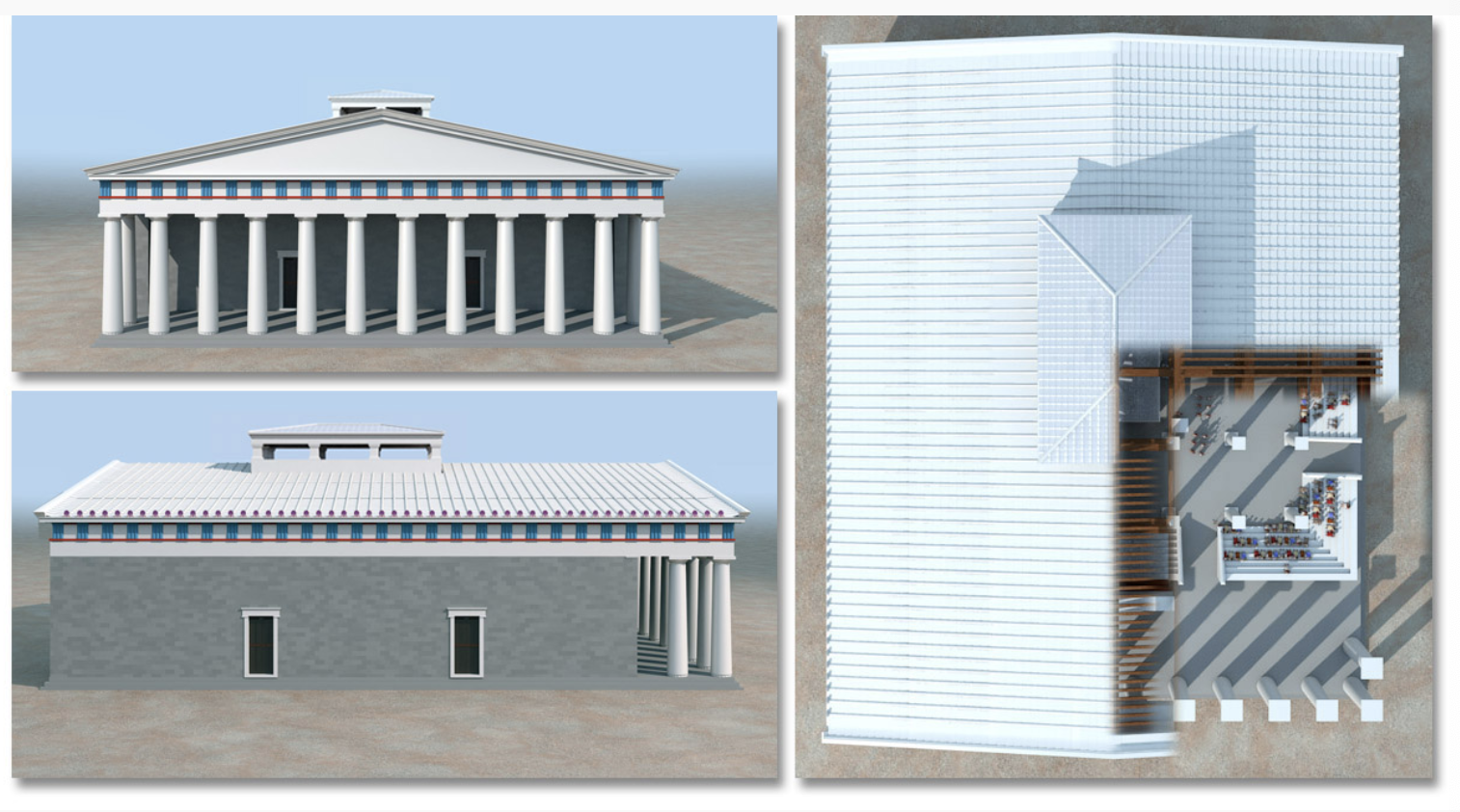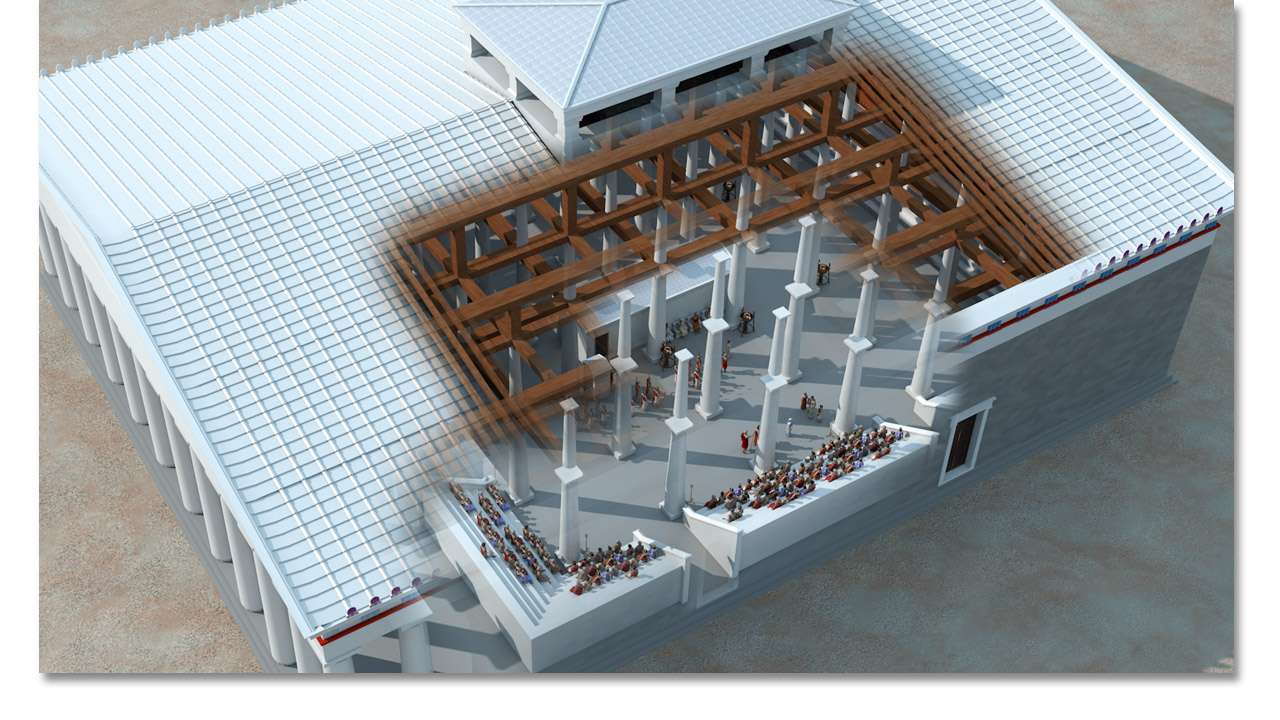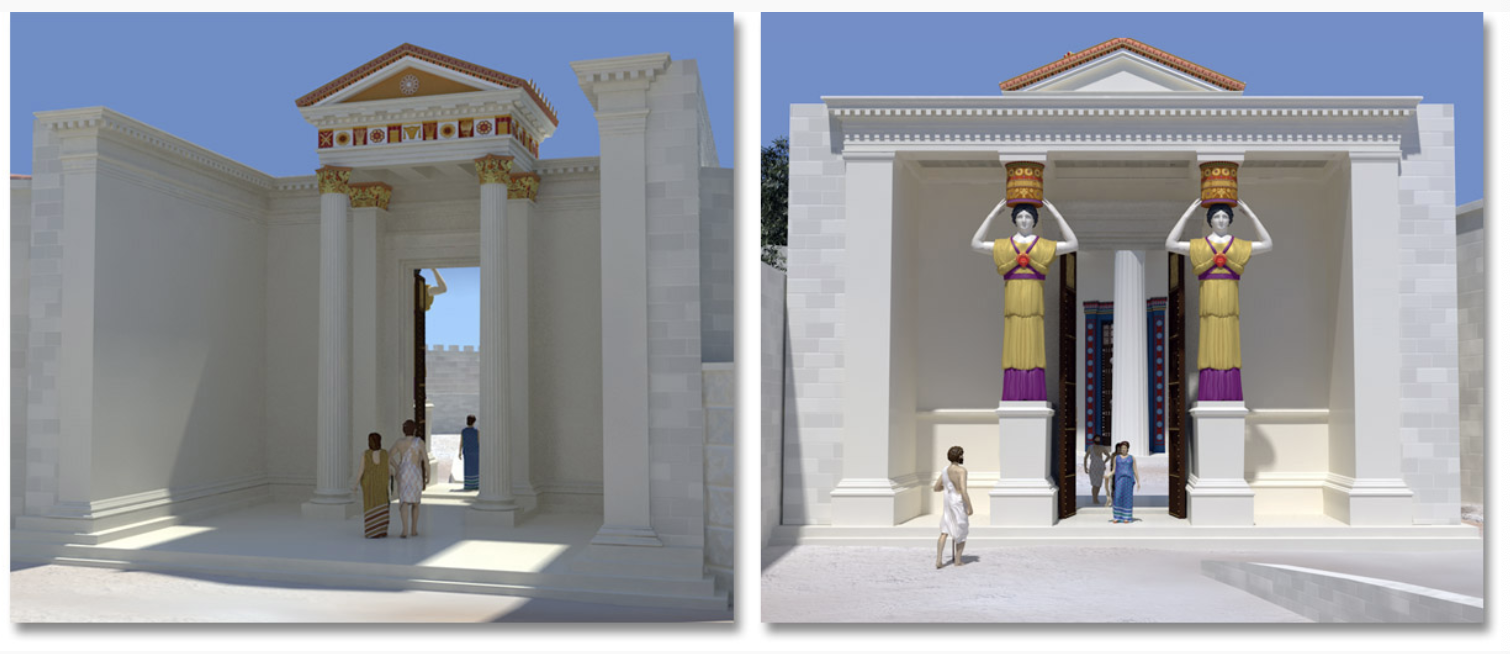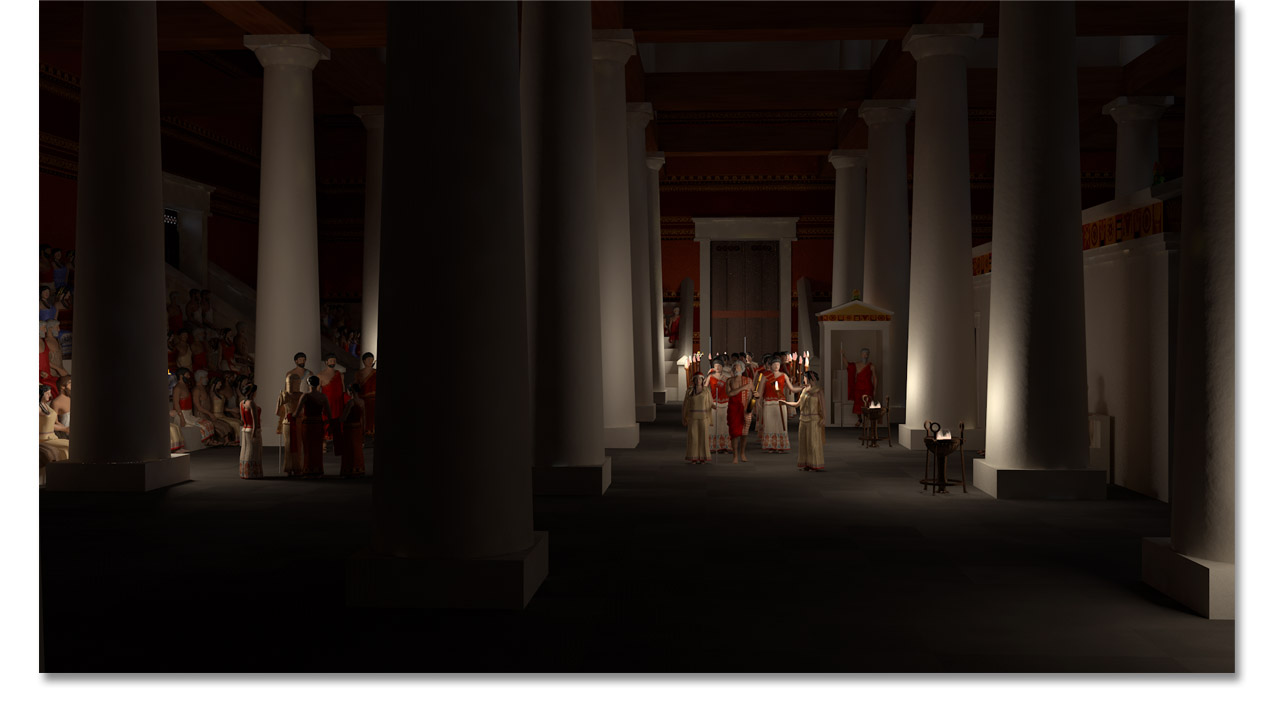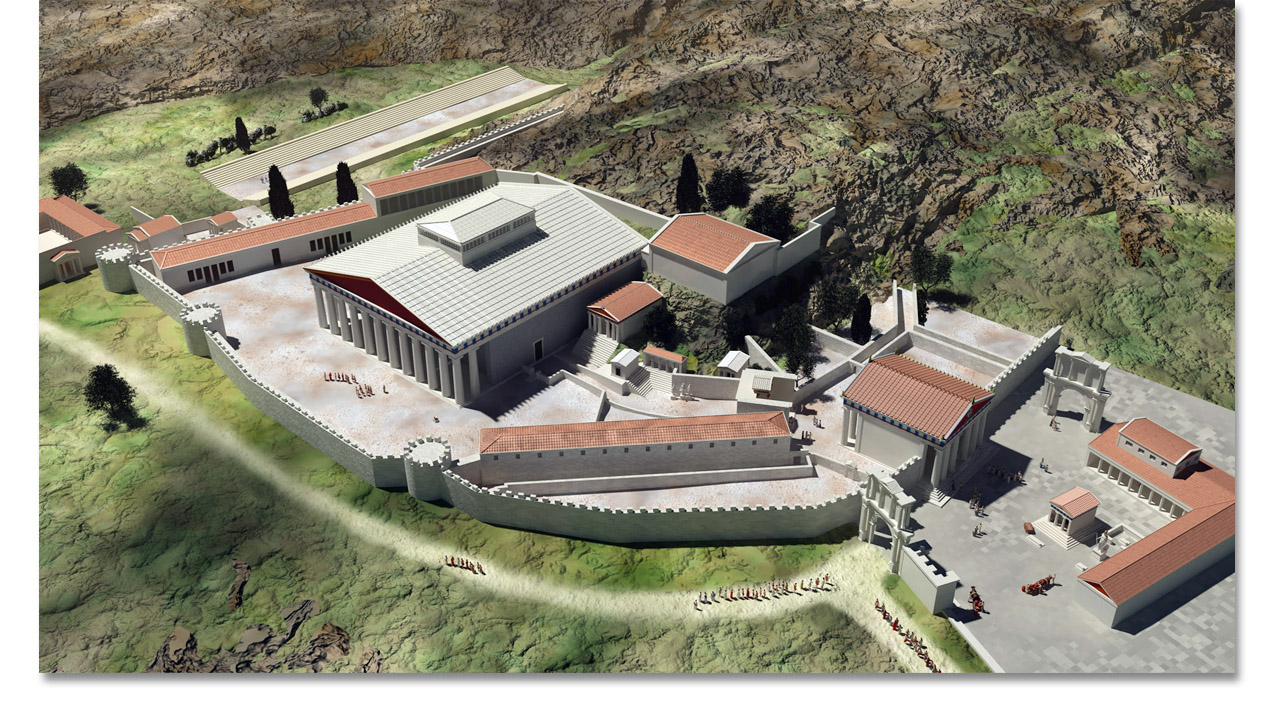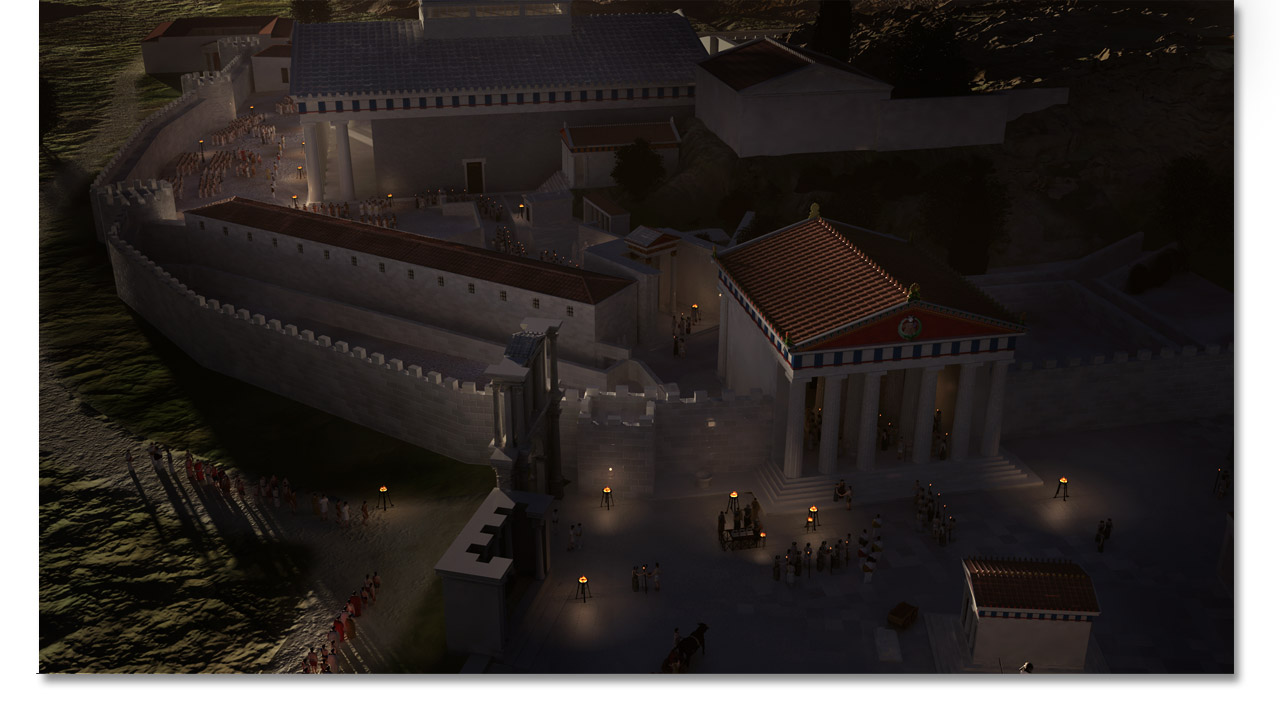Eleusinian Mysteries
- Intro
- The End
- Telesterion
- Ancient Testimonies on the Eleusinian Mysteries
- The Rite
- Kykeon - Hypothetical Recipe
- Mechanics of the Mystery
- Pilgrimmage Schedule - from ancient sources
- Pilgrimmage Schedule - from today's social media
- Pharmacology Hypothesis
- Books mentioning Eleusinian Mysteries
- See Also
- Pictures of the Telesterion
Intro
The Eleusinian Mysteries were the most renowned initiation rites of the ancient Greek world, celebrated annually at Eleusis, a small deme about 14 miles (22 km) west of Athens. Traditionally founded in the Mycenaean period (c. 1500 BCE), with the rites firmly established by the 7th–6th centuries BCE under Athenian control, they endured for nearly two millennia, until their violent suppression by the Gothic sack of Eleusis under Alaric in 396 CE.
The cult was devoted to Demeter and Kore (Persephone), goddesses of fertility, agriculture, and the cycle of life and death. Administration of the Mysteries rested in the hands of two priestly families: the Eumolpidae (hereditary hierophants) and the Kerykes (heralds and assistants). These families maintained the sacred ritual knowledge generation after generation.
The initiatory cycle included both the Lesser Mysteries, held in spring at Agrai by the Ilissos river, and the Greater Mysteries, held in autumn (Boedromion, roughly September). Pilgrims—sometimes tens of thousands—walked the Sacred Way from Athens to Eleusis, a journey of about 14 miles, which took a full day and included several ritual halts at shrines and altars (notably at the Cephisus River and at the bridge where initiates were jested at). The entire festival of the Greater Mysteries lasted nine days, echoing Demeter’s nine-day wandering in search of her daughter.
Ancient writers often praised the Mysteries in the highest terms. Cicero (Laws 2.36) called them “the most excellent and divine thing Athens ever produced, for from them we have learned the beginnings of life and gained the power not only to live in joy, but also to die with a better hope.” Conversely, some critics, like early Christian polemicists (e.g. Clement of Alexandria, Hippolytus), denounced them as shameful orgies or demonic rites.
For nearly 1,800 years, the Mysteries shaped Greek and later Roman religious imagination. Their central promise—that initiates would experience a blessed fate in death—made them not just a local cult, but the spiritual heart of the Greek world until the Christian emperors closed the sanctuaries and Alaric’s troops destroyed Eleusis in 396 CE, ending one of antiquity’s longest-lived and most influential mystery traditions.
The End
The Mysteries were eventually closed (Theodosius the Great, AD 379- 395) by legislative decrees that outlawed the rites of the ancient religion. The Goths dealt the final blow to Eleusis in AD 396. The Telesterion and sanctuary of Eleusis were destroyed. The priesthood then ceased to exist.
Telesterion
The Telesterion, the great hall of initiation for the Eleusinian Mysteries, is located in the modern town of Elefsina (Ελευσίνα) in Greece.
- Ancient name: During the period of the Mysteries, the town was called Eleusis (Ἐλευσίς).
- Modern name: Elefsina (sometimes spelled Eleusina) is the contemporary Greek town built in roughly the same location, just northwest of Athens.
So the name has changed slightly over time, but the site is geographically continuous.
Ancient Testimonies on the Eleusinian Mysteries
Our most direct window into the Eleusinian Mysteries is not archaeological but literary: the scattered remarks of ancient authors who hinted, with reverence or critique, at what was experienced within the Telesterion. Their voices provide a chorus of praise, awe, and sometimes suspicion.
- Cicero (De Legibus 2.36):
“Athens has given nothing more excellent, nor more divine, to mankind than those Mysteries. For in them we are initiated and formed not only to live with joy, but also to die with a better hope.”Cicero’s testimony is perhaps the most famous, casting the Mysteries as essential to human flourishing and the hope of blessedness after death.
- Isocrates (Panegyricus 28):
“She [Athens] has given us the greatest of all gifts: the Mysteries, through which we have become gentler, and have advanced from a savage and uncivilized mode of life to humanity and civilization.”Here the Mysteries are presented as a civilizing force, turning human life from barbarity to culture.
- Sophocles (Fragment 837 Nauck):
“Thrice-blessed are those of mortals, who having seen those rites depart for Hades; for to them alone is it granted to have true life there. To the others, all evils await.”Sophocles stresses the post-mortem benefit: the Mysteries granted initiates a kind of real “life” beyond the grave.
- Aristophanes (Frogs 455–459):In comic vein, Aristophanes portrays initiates in the afterlife dancing and rejoicing, contrasting their fate with that of the uninitiated. Though humorous, it reflects the wide cultural assumption that the rites assured happiness after death.
- Plutarch (On the Soul 81D–E):
“Just as those who are being initiated into the Mysteries are seized with terror and shuddering, then are filled with amazement and joy, and crowned with light… so does the soul pass through death.”Plutarch links the ritual stages to the soul’s passage into the afterlife, suggesting the initiatory drama rehearsed the very process of dying.
- Christian Critics:By late antiquity, Christian polemicists like Clement of Alexandria (Protrepticus 2.12) denounced the rites as shameful, pointing to their secrecy and mythic dramatizations as evidence of pagan superstition. Yet even their criticism admits the rites’ power and cultural centrality.
Quick List
- Homeric Hymn to Demeter 208–211 – “She asked them to make a potion: barley, water, and tender pennyroyal (γλήχων).”
- Aristophanes, Frogs 320–330 – procession cries of Ἴακχε! with torches.
- Plutarch, Alcibiades 34 – profanation of mysteries outside Eleusis, drinking the kykeon.
- Cicero, De Legibus 2.36 – calls the Eleusinian Mysteries “the greatest gift of Athens.”
- Hippolytus, Refutatio 5.8.39 – mocks the rites, but notes the ritual drinking.
The Rite
The Eleusinian Mysteries were an initiatory cult practice centered on the myth of Demeter and Persephone, spanning over two millennia in classical Greece (c. 1500 BCE – 396 CE). Initiates underwent a multi-day journey, combining physical pilgrimage, ritual purification, sacrificial offerings, and the consumption of a sacred beverage called kykeon, traditionally made from barley and possibly psychoactive additives such as ergot (Claviceps purpurea) or other entheogenic plants.
The ritual began in Athens with public proclamation and gathering of initiates (Ἀγύρσις), followed by purifications in the sea at Phaleron, including pig sacrifice, and culminated in the procession of sacred objects (ἱερά) along the Sacred Way to Eleusis. The journey covered approximately 14 miles, with stops for rest, ritual offerings, and reflection, allowing initiates to transition from the profane to the sacred.
Once at Eleusis, participants engaged in all-night vigils (παννυχίς), before entering the Telesterion, the hall of initiation. Inside, they experienced μύησις (the preliminary initiation) and ἐποπτεία (full revelation), culminating in a direct encounter with the divine mysteries. These experiences were highly controlled, guided by priesthoods and often cloaked in secrecy, designed to induce intense visionary states, possibly pharmacologically mediated through the kykeon.
Scholars like Wasson, Ruck, and Hofmann hypothesize that the kykeon’s psychoactive properties—through ergot alkaloids or other natural additives—produced profound effects on perception, emotion, and cognition, giving initiates a vivid sense of communion with cosmic justice and divine life. Muraresku extends this hypothesis to argue that early Christian ritual practice borrowed from this “religion with no name,” adopting entheogenic sacraments, symbolic narrative structures, and the ethos of secret initiation, which persisted in altered form into Christian liturgy.
The rite thus combined physical pilgrimage, ritual purification, sacred ingestion, and visionary experience into a coherent transformative process, producing both a sense of cosmic insight and a tangible connection between the mortal and divine realms.
Kykeon - Hypothetical Recipe
Base Ingredients (from Homeric and Classical sources):
- Barley or barley flour — the main grain component (ἄρτος or κριθή)
- Water — to macerate the grain into a drink
- Mint or pennyroyal — flavoring and mild psychoactive effects (Mentha pulegium)
- Honey — sweetener
Optional (Pharmakon Hypothesis for the psychedelic effect):
- Claviceps purpurea (ergot) sclerotia — carefully macerated, water-extracted to reduce toxic alkaloids while retaining psychoactive properties
Preparation Method:
- Grind barley into coarse flour.
- Macerate in water, stirring into a porridge-like consistency.
- Add mint/pennyroyal for aroma and taste.
- Optional: Add water-extracted ergot, filtering solids carefully (polar solvent extraction reduces vasoconstrictive toxicity).
- Sweeten with honey to improve palatability.
- Serve cold or room temperature in a cup or ceremonial vessel.
Notes:
- Ancient sources (Homeric Hymn to Demeter, Plato) emphasize barley, water, and mint; ergot is a modern pharmacological hypothesis.
- The beverage was likely consumed during the procession or immediately before initiation into the Telesterion.
- Effects may have been a visionary or mystical experience. Inducing heightened perception, and a sense of the sacred.
Mechanics of the Mystery
It's thought that the story given via hymn and song, theater and chorus and their costumes, the travel on foot, the music, the fasting, the setting, and the drink Kykeon (including any psychoactives) all worked in tandem to guide the initiate mind to the proper place.
We understand today there are direct mystical experiences to be found with psychedelics, evidenced from trip reports and books written since the 1960s psychedelic culture.
We understand from [LadyBabylon] and directly from ancient greek source texts, that pharmakon magia (drug magic) and rites with the pharmakon including music/story/hymn/sex was a science in the ancient Greco/Roman world's rites.
The general mechanics are outlined in these:
- see also Revelation 921 recipe for the mystery rite - a general description (and condemnation) from Abrahamic authors
- see also Hypatia Gnostikoi#Consciousness for very general mystery breakdown across all religions (not just specific to Hellenic)
Pilgrimmage Schedule - from ancient sources
(based on Philostratus, Pausanias, Plutarch, Aristophanes, Hymn to Demeter, scholia, and ritual calendar fragments)Festival Timeline (Boedromion, Sept/Oct)
Here, we focus on when events happen, using the Attic calendar dates (14–23 Boedromion). It is chronological, showing the sequence of rites, purifications, offerings, processions, and initiations. It gives a temporal framework for the festival.
- 14 Boedromion – Ἀγύρσις (“the gathering”): proclamation in the Agora, summoning initiates.
- 15–16 – Ἅλαδε μύσται: purifications in the sea at Phaleron; pig sacrifice.
- 17 – Offerings at Eleusinion (Athens).
- 18–19 – Preparations, sacrifices.
- 19 Boedromion – Procession of the sacred objects (ἱερά) from Eleusis to Athens, stored in the Eleusinion.
- 20 Boedromion – The great procession sets out from Athens to Eleusis along the Sacred Way (14 miles).
- this is when the procession walks to those Sacred Way Stations (listed below).
- 20–21 – Arrival at Eleusis, all–night vigil (παννυχίς).
- 21–23 – Initiations (μύησις and ἐποπτεία) inside the Telesterion.
- Note: 14 Boedromion is a date in the Attic calendar
- The Attic calendar was a lunar-solar calendar used in classical Athens. Each month had 29–30 days.
- Boedromion is the eighth month of the Attic year (roughly September/October in the Julian/Gregorian calendar).
- So 14 Boedromion means the 14th day of the month of Boedromion.
- The Eleusinian Mysteries were held annually in this month; the festival’s events are often anchored to these dates.
- That’s why the itinerary starts at 14 Boedromion
Sacred Way Stations (ἱερὰ ὁδός)
Here, we focus on where the initiates went during the procession from Athens to Eleusis. It highlights the physical and experiential journey, including the stops, sights, and rituals at each location. It gives a geographical and sensory perspective.
The Sacred Way journey occurs within the Festival Timeline, specifically around 20 Boedromion when the great procession leaves Athens for Eleusis.
- Athens (Kerameikos Gate / Dipylon)
- The procession departs with sacred objects carried in κίστη and κάλαθος (chests and baskets).
- Cry: Ἴακχε! ὦ Ἴακχε! — invocation of the youthful daimon.
- Interpretation: Initiates fasted (Day of Epheta), preparing stomach and mind for pharmakon ingestion.
- Sacred Bridge over Cephisus (Gephyraion)
- Mockery (γεφυρισμοί): obscene jests, insults, and laughter directed at passers.
- Rooted in the tale of Iambe (Homeric Hymn to Demeter, vv. 190–205), whose ribaldry made Demeter smile.
- Interpretation: Laughter disarms fear before the pharmakon, creating communal bond.
- Shrine of Apollo at Daphne / Altars to Acheloos and Gaia
- Libations poured; initiates chant hymns.
- Interpretation: Early offerings likely included kykeon precursors — barley meal + mint.
- Rheitoi Lakes (near modern Chaidari)
- Twin sacred ponds dedicated to Demeter and Persephone.
- Only priests could fish here.
- Interpretation: Crossing into liminality. The lakes = boundary of the sacred precinct.
- Bridge of the Athenian Boundary (near Skiron)
- Skiron was a hero associated with purification and liminal passage.
- Interpretation: Transition point. Some sources suggest initiates consumed the first sip of kykeon here.
- Crocodilion / Sacred Figs
- Ritual pause under the ἱερὰ συκᾶ (holy fig trees).
- Figs linked to Demeter (fertility, satiety).
- Interpretation: Possibly a first solid food after fasting — sweet figs easing the stomach before full draught of the potion.
- Outer Court of Eleusis (Kallichoron Well)
- Arrival at Eleusis proper. Dancing and hymns sung around the well where Demeter rested (Hymn to Demeter 270–274).
- Interpretation: Here the kykeon proper — a barley + mint drink, possibly infected with ergot or darnel fungus — was ritually consumed.
- Telesterion (Hall of Initiation)
- The vast hall where the mysteries climaxed.
- Three stages: 1. Μύησις (initiation, vision of sacred things).
- Δεῖξις (showing of sacred objects, e.g. ear of wheat).
- Ἐποπτεία (beholding, “second initiation”).
- Interpretation: Here the pharmakon’s full visionary effects aligned with hierophant’s vision of the divine light and queen Persephone.
Pharmakon Layering
- Fasting (17–20 Boedromion) → physiological sensitization.
- Kykeon: Barley + mint (official formula, Hymn to Demeter 208–211). If barley came from the Rharian plain, possibly infected with Claviceps purpurea (ergot) or Lolium temulentum (darnel), psychoactive alkaloids would trigger visions.
- Wine + opium (testified in parallel Dionysian rites) may have been additives.
- Ergotized barley explains why only initiates in good health could safely take part.
Pilgrimmage Schedule - from today's social media
Posted by Facebook Group: "Elefsinion Keren-Or Sta Mysteria Tis Psyches - Temple of Eleusinian Deities"
Today from sunset is Nouminia and begining of month Boedromion.
This year, 1st year of the 701st Olympiad in month of Boedromion 14-24 will be the celebration of the Greater Mysteries 2025 dates: Sept 6-16
Rules to participate:
- Speak and understand greek fluently (“everyone who has clean hands and intelligble speak”)
- Never shed blood of humans
- *women, men, children and even slaves can participate
- Who can partcipate:
- priests and priestesses and hierophants
- people who are following the rules and it’s their first time
- people who at least participated once
- the blessed ones who reached Epopteia
- It was not allowed to speak about the events of the Mysteries, those who did or tried were killed.
Days of Celebration month Boedromion (keep in mind each day begins at sunset):
- 14 - (6/9)- The Ephebes escort the Hiera (sacred objects) from Eleusis to the Eleusinion in Athens
- 15 - (7/9)- Aghyrmos :day of Gathering
- the official day of the beginning of the Mysteries. Archon Basileus (Magistrate of Athens) call the celebrants to Stoa Poikile in Ancient Agora. On this day the Proclamation call people to take part in the celebration of the Mysteries. Only those that followed the rules could participate the others needed to abstain.
- The initiates pay their fees.
- 16 - (8/9)- Elasis :To the sea, Mystai (initiates) - purifications
- All participants rode in carriages (origin of the name of that day) to the sea to cleanse themselves accompanied by their sponsors (Mystagogos) and carried a small pig to be washed in the sea and later be sacrificed probably immediatly after they returned. The pig meant to purify the soul of the the Mystes.
- 17 - (9/9)- Hiereia Deuro: Day of Sacrifices
- this day is meant for the Sacrifices of the Archon and each city-state would give her prayer and sacrifices to the Goddesses and blessings to the people. Also a day of private sacrifices to the goddesses: Demeter and Kore
- 18 - (10/9)- Epidauria or Asklepeia: annual festival to Asklepius in Athens
- it is said on this day the god came to be initiated into the Mysteries from Epidauros. Since he missed the purifications and sacrifices, this day is meant to repeat the rituals so the god could take part in the Mysteries. It allowed people who came from afar and were late to be able to participate in the celebration.
- The Mystai rested on this day and started preparing for the following days.
- 19 - (11/9)- Pompe: the procession
- this day is known as the Iacchos or Pompe. Rites and festivities in Athens and the return to Eleusis. The armed Ephebes (teens who were trained by the Kosmetes-magistrate in charge of the young men) were crowned with Myrtle. The gathering of the initiates and their sponsors was probably in the Pompeion near the Dipylon gate. They wore festive clothes. In their hands they carried Iacchos made from branches of myrtle and tied by wool and accompanied by a priest. They also carried their supplies. The Priests and Priestesses led the Procession with the Hiera inside a Kistai (sacred chests)
- They passed through the Sacred way:
- Sanctuary of Apollon
- Sanctuary of Aphrodite
- River Rheitoi
- After the initiates cross the bridge, they are taking part in rite of kroke. They tie a wool of saffron color to their right hand and left leg of each Mystai. It meant to avert evil.
- Before reaching Eleusis, they cross the Eleusinian Kephisos. On the bridge men standing mocking the passers by. It was also as apotropaic rite and merriment and might connected to story of Baubo and Goddess Demeter. Arrival at night and dancing around the Kallichoron Well welcoming Iacchus.
- 20-21 - (12-13/9)- Telete: The night of the Initiation - the day of initiation started with resting and fasting, purification and sacrificing. The fasting is as a reminder and imitation of Demeter’s fasting after the abduction of Persephone. It could be partial or total.
- Food that are not allowed - mullet, dog-fish, black tails (fishes), some birds including the cock which is sacred to Persephone, beans, pomegranates, apples,eggs and flesh of animals not properly killed.
- It is not permitted to touch a dead body or a woman who just gave birth. Also abstained from wine.
- The closing of the fast was by drinking Kykeon, barley meal mixed with water and soft mint.
- Initiation begins:
- Dromena (things that are enacted)- includes sacred pageant which dealt with the story of the abduction of Persephone, wandering of Demeter and the reunion of the two Goddesses in Eleusis.
- Legomena (things that are told)- short liturgical statements and explanations and probably invocations.
- Deiknymena- (objects that are shown)- the Heirophant standing infront of the Anaktoron and in the midst of a radiant light exhibited the Hiera to the Mystai.
- 21 - (13/9)- Epopteia: sacred objects revealed to the ones who were in higher degree of initiation.
- 22 - (14/9)- Plemochoai: libations to the dead - special vessels are filled with liquid one faced east and the other west they are turned and the liquid poured down to the ground (some sources indicates it was in the entrance of the Plutoneion). While the liquid was poured , the initiates shouted “rain!” “conceive!”
- The end of the day festivites included dancing and singing
- 23 - (15/9)- The return to Athens in an organised pompe: in the return to Athens there was the rite of mocking in the Athenian Kephisos.
- 24 - (16/9)- Assembly in the Eleusinion: report of the Archon regarding the events that taken place in the celebration.
Many Blessings on your journey and celebrating the sacred rites!
Pharmacology Hypothesis
Many have proposed a pharmakon hypothesis to go along with the rite. As seen in ancient greek language texts, there is much evidence of pharmakon use to augment pre-christian Hellenic mystery rites across those traditions, so this hypothesis is very plausible for the earlier Eleusinian cult.
Complete list of pharmacology hypotheses
- Claviceps purpurea (ergot) on barley or rye – Proposed by Wasson, Ruck, and Hofmann. Ergot alkaloids could produce visions, altered consciousness, and mystical experiences. Psychoactive effects may have been dose-controlled to avoid convulsions or gangrene.
- Claviceps paspali on Paspalum/distichum grasses – Suggested by Peter Webster. Considered safer than Claviceps purpurea, possibly infused into kykeon for milder psychoactive effects while avoiding toxicity.
- Darnel (Lolium temulentum) – A grass sometimes found mixed with cereal grains. Produces mild hallucinogenic and intoxicating effects due to loline alkaloids. Some ancient texts reference “drunken” barley; this could be a partial source.
- Psychoactive fungi other than ergot – Hypotheses include psilocybin mushrooms or other psychoactive fungi growing in the region. Proposed effects would mimic visionary states; however, there is no direct archaeological evidence.
- Ethereal herbs in kykeon – Some suggest mint, pennyroyal, or other bitter herbs added to the barley mash could potentiate or modulate psychoactive effects, and also improve palatability.
- Opioid or poppy derivatives – Less frequently suggested, but some theorists posit trace use of opium or poppy latex in the drink to induce relaxation and mild euphoria.
- Thionic or sulfurous additives – Speculative proposals involve local plants like rue or wild rue (Peganum harmala), which contain MAO inhibitors and could potentiate other psychoactive compounds in the kykeon.
- Combination polypharmacy – Wasson and Muraresku suggest the mysteries may have used multiple ingredients—ergot, herbs, bitter decoctions—to create a controlled visionary experience, analogous to later Mithraic or Orphic pharmaka.
- Alcoholic base – While barley/water is traditional, some propose fermentation into a mild beer-like kykeon, which could potentiate psychoactive compounds while making ingestion easier.
- Non-psychoactive symbolic kykeon – Some classical scholars argue the kykeon may have been mostly symbolic, with ritual, chant, and environmental context inducing ecstasy rather than any pharmacological ingredient.
Books mentioning Eleusinian Mysteries
The Road to Eleusis - 1978 - by Wasson, Ruck, Hoffman
Wasson–Hofmann–Ruck put forward the hypothesis that the κυκεών of Eleusis contained an ergot-derived alkaloid, specifically from Claviceps purpurea or a closely related ergot fungus (possibly from Claviceps paspali growing on distichum grass in the plain).Their reasoning was tied to the Rharian plain (Ῥάριον πεδίον), sacred to Demeter, which was famed in antiquity as the “first wheat field.” Hypothesis that the "purple" color of the Claviceps purpurea slerotia corresponds with Demeter's color also.
Here’s the philological and agricultural complication:
- Wheat (πυρός / σῖτος) — Traditionally associated with Demeter, but Mediterranean wheats (einkorn, emmer, durum) are not the best hosts for ergot. Claviceps does grow on wheat, but less frequently than on rye or barley.
- Barley (κριθή) — The Homeric Hymn to Demeter explicitly says the kykeon was made with barley (ἄλφιτον, αλφιτα). Barley is a much better host for ergot than Mediterranean wheats. In fact, archaeological evidence shows ancient ergot sclerotia in barley storage pits.
- Darnel (Lolium temulentum) — A toxic ryegrass known since antiquity, often found growing among wheat/barley. The Greeks called it ζιζάνια or αιγάγρωστις. Consuming it caused dizziness, confusion, and intoxication. Hesychius and Galen mention its stupefying effect. Importantly: darnel itself can harbor ergot fungus as well.
- Rye (Secale cereale) — Rare in the Greek world. Rye was a weed among wheat/barley until much later, and it only became a major crop in northern Europe in late antiquity/early medieval times. It would not have been the Eleusinian vector.
Barley is most likely, maybe darnel
- The ergot hypothesis does not depend only on wheat. More likely, barley was the sacramental grain, with darnel possibly acting as an additional vector of intoxication. The barley in the Rharian plain could easily have carried ergot sclerotia, especially in damp years.
- In antiquity, people knew barley could go “bad” and cause illness.
Extraction
- Hoffmann (and Jonathan Ott who translates Hoffmann) informs us that macerated purple ergot slerotia of Claviceps purpurea could be safely extracted using a cold-water extraction then filtration of the solids using a wollen filter. Water (polar solvent) extracts lysergic acid amides (LSAs) and would avoid extracting most of the toxic ergot alkaloids (ergotamine, ergotoxine, etc.) that are more soluble oil, fat, or ethanol (non-polar solvents). Thus avoiding the extreme vasoconstriction that leads to gangrene (St Anthony's Fire), pain, and death.
- Jonathan Ott later clarified Hofmann’s remarks in his own writings (Pharmacotheon, etc.).
- Peter Webster (in "The Eleusinian Mysteries: The Secret of the Kykeon") proposed that Claviceps paspali (ergot on Paspalum distichum grass) would have been safer and easier to extract. Could have been soaked into the Kykeon "beer" recipe to infuse it with the psychoactive property without worry of toxicity. Some worry remains with "cattle staggars" seen when cattle feast on distichum grass infected with Claviceps paspali, but unknown if a single dose would invoke that symptom or not.
The Immortality Key - by Brian Murarescu
In The Immortality Key, Brian Muraresku delves into the ancient origins of religious rituals, proposing that the consumption of psychedelic substances played a pivotal role in the spiritual experiences of early Christians. He suggests that these practices were inherited from ancient Greek traditions, particularly the Eleusinian Mysteries. To The Best Of Our Knowledge.
The Religion with no Name
In The Immortality Key, Brian Muraresku refers to a “Religion With No Name” to describe a hidden, pan-Mediterranean tradition of psychoactive sacramental rites that predates and underlies both classical paganism and early Christianity. This religion was not codified in sacred texts or temples but transmitted through initiatory mysteries—most famously the Eleusinian Mysteries—where participants consumed a psychoactive kykeon to induce visionary states. According to Muraresku, this tradition emphasized direct, embodied encounters with the divine, uniting sexual, vegetal, and cosmic elements, and its core practices—ritual ingestion of entheogens, communal initiation, and ecstatic communion—were later absorbed, disguised, or repurposed by emerging Christian rituals, forming the hidden spiritual backbone of the Western religious heritage.
Eleusinian Mysteries and the Kykeon
Muraresku examines the Eleusinian Mysteries, a series of ancient Greek religious rites dedicated to Demeter and Persephone. Central to these rites was the consumption of a ritual drink known as the kykeon. While traditionally thought to be a simple mixture of barley and water, Muraresku posits that the kykeon may have contained psychoactive substances, possibly derived from ergot-infected barley, inducing altered states of consciousness among initiates.
Early Christianity and the Eucharist
Drawing parallels between the Eleusinian Mysteries and early Christian practices, Muraresku suggests that the Christian Eucharist—symbolizing the body and blood of Christ—may have roots in these ancient psychedelic rituals. He proposes that early Christians, particularly in regions like Anatolia, continued the use of psychoactive substances in their religious ceremonies, thereby preserving and transforming the traditions of the Mysteries.
Modern Implications
Muraresku's hypothesis challenges conventional understandings of religious history, suggesting that the use of psychedelics was not only prevalent in ancient times but also integral to the formation of Western religious traditions. He calls for a reevaluation of the role of psychoactive substances in spiritual practices and their potential benefits in modern contexts.
See Also
- see also LadyBabylon for overview of Hellenic mystery cults direct from greek sources
- The Mystery of Manna: The Psychedelic Sacrament of the Bible
- The Road to Eleusis: Unveiling the Secret of the Mysteries
- Mystery Cults in the Ancient World
- Initiation into the Mysteries of the Ancient World (Munchner Vorlesungen Zu Antiken Welten) (Munchner Vorlesungen Zu Antiken Welten, 1)
- The Immortality Key: The Secret History of the Religion with No Name
- Google search for Eleusis Telesterion
- Artist Renditions, from Assassin's Creed
Pictures of the Telesterion
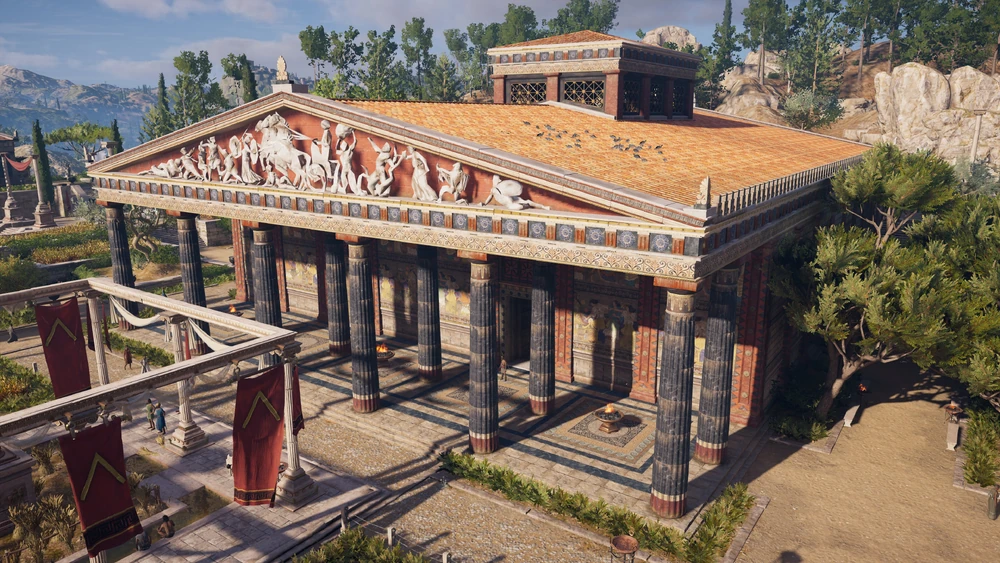
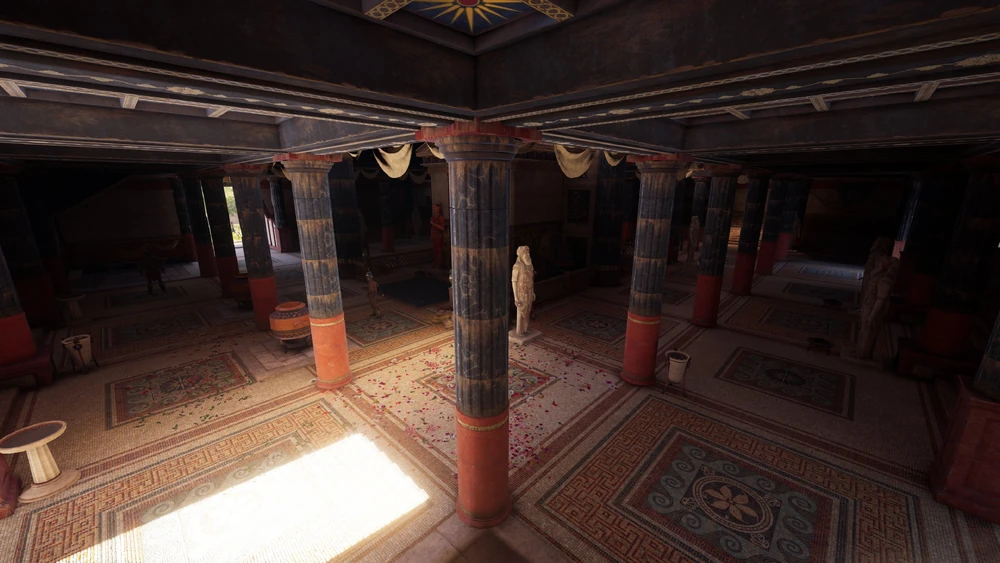
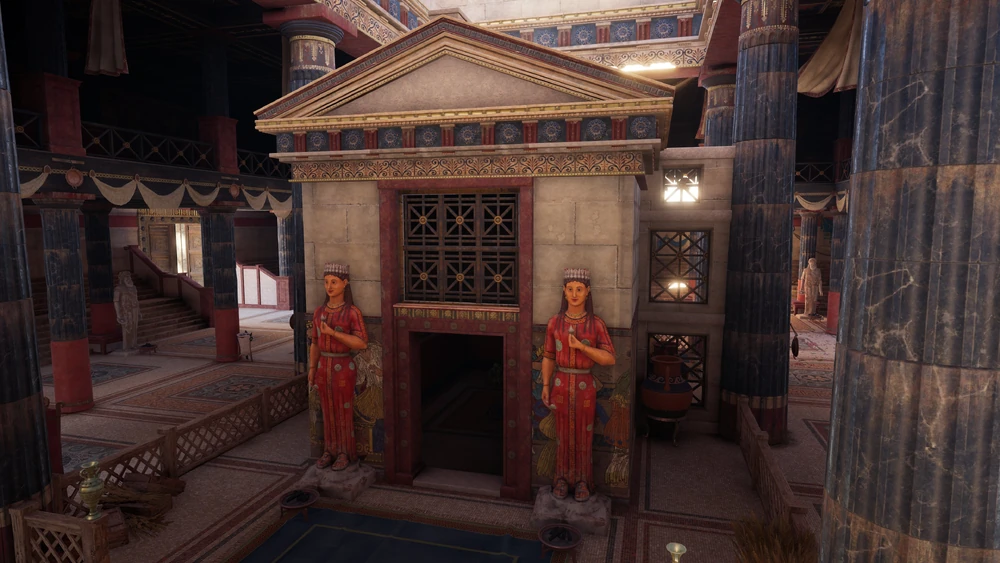
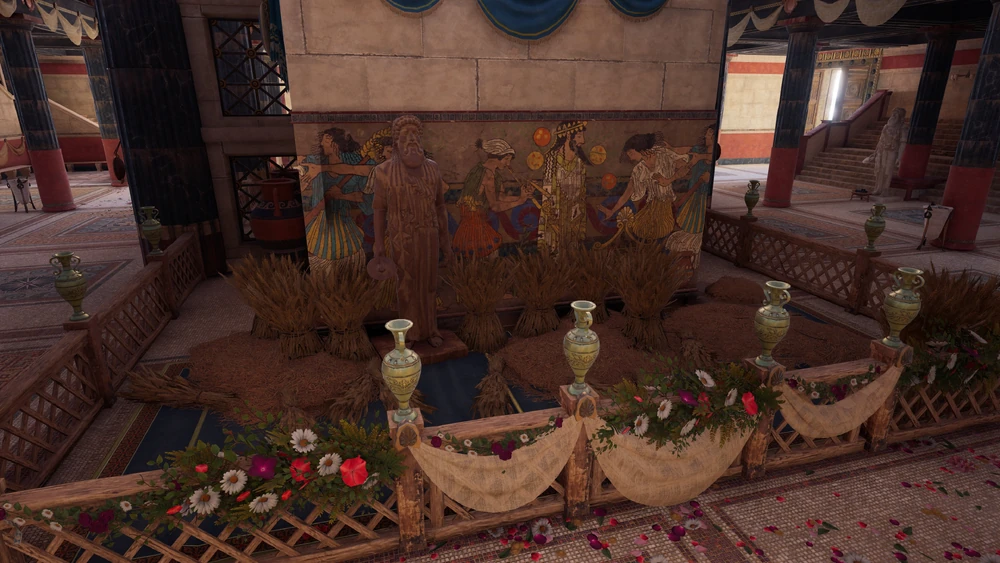
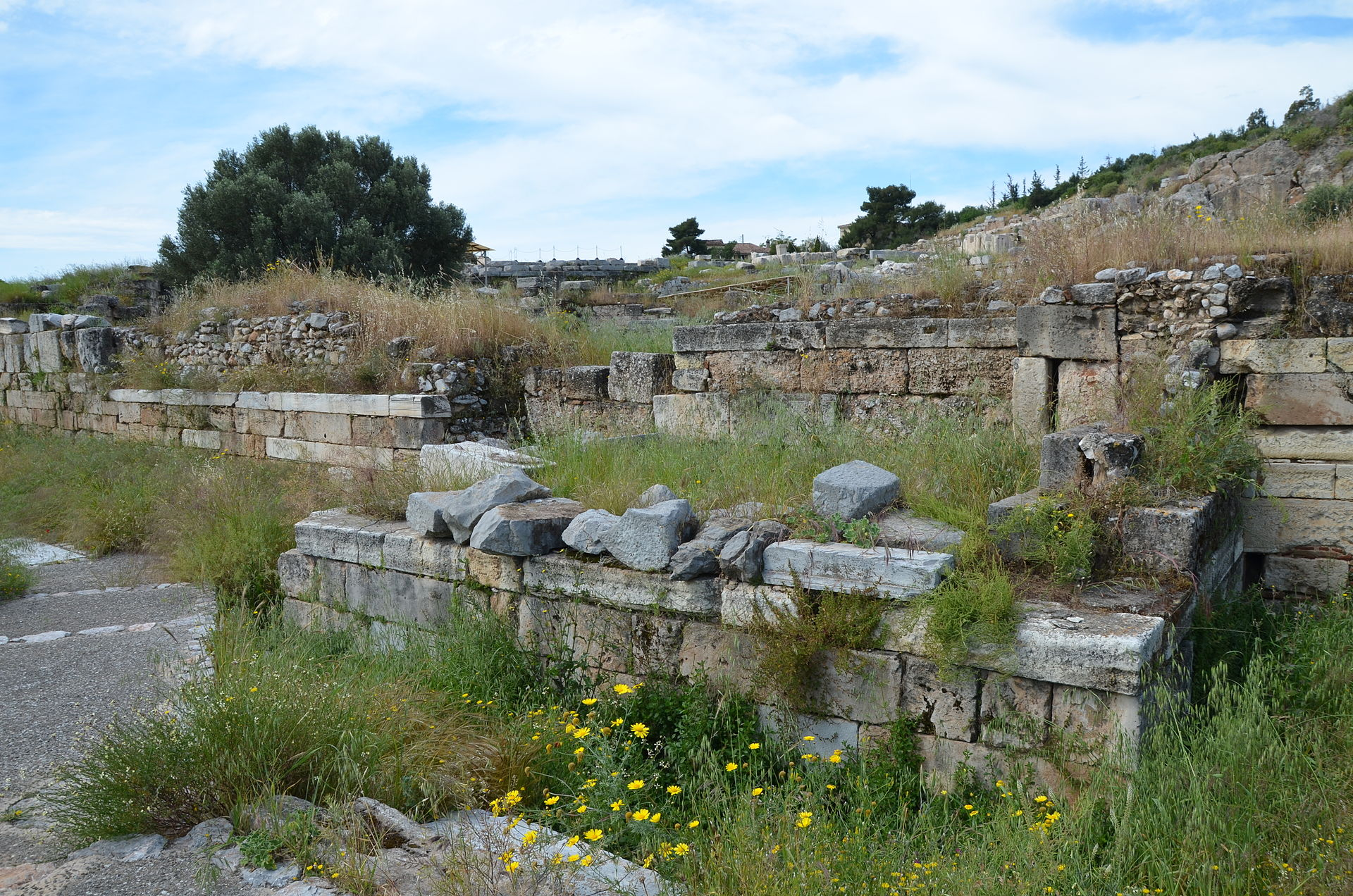
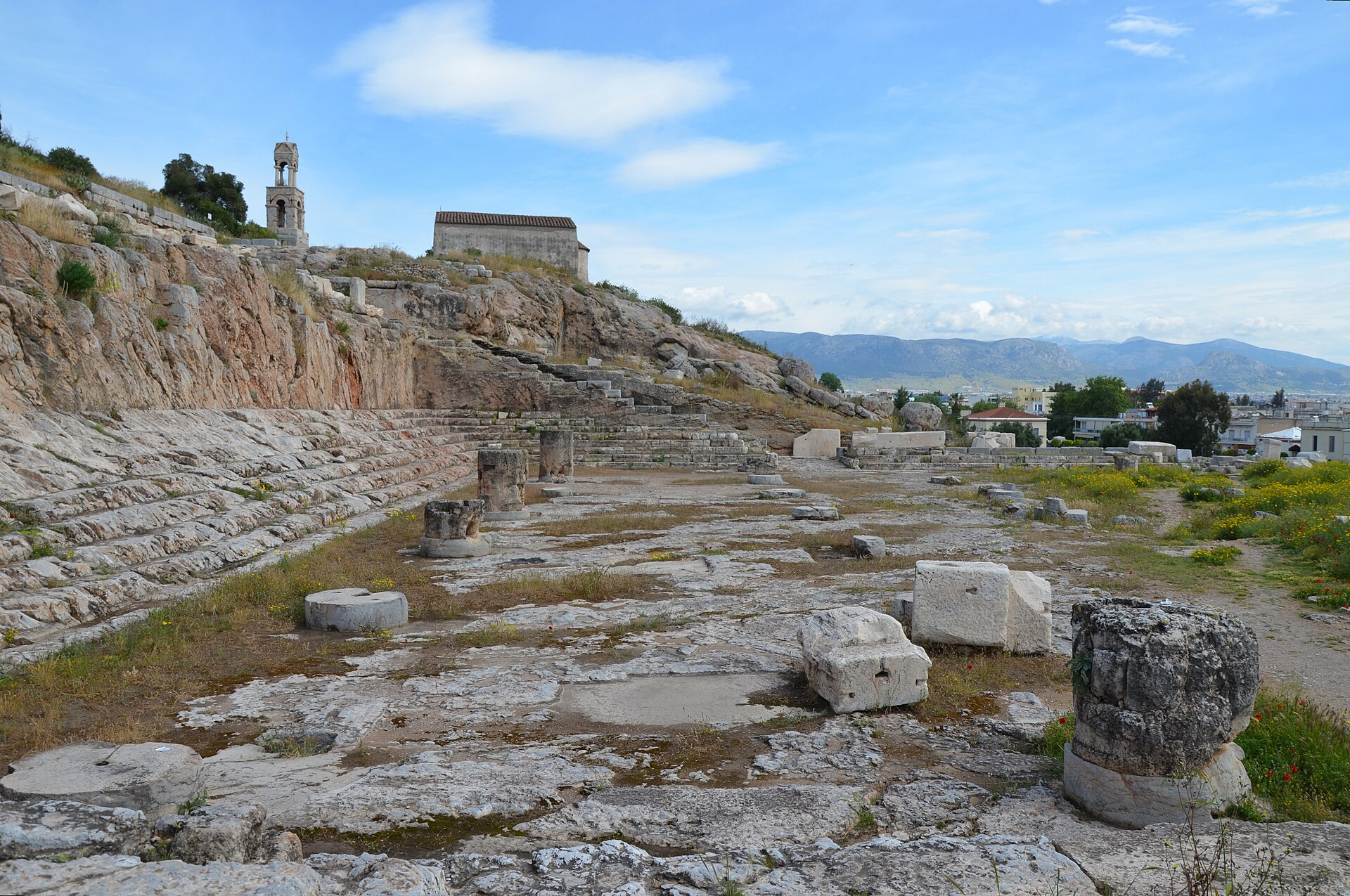
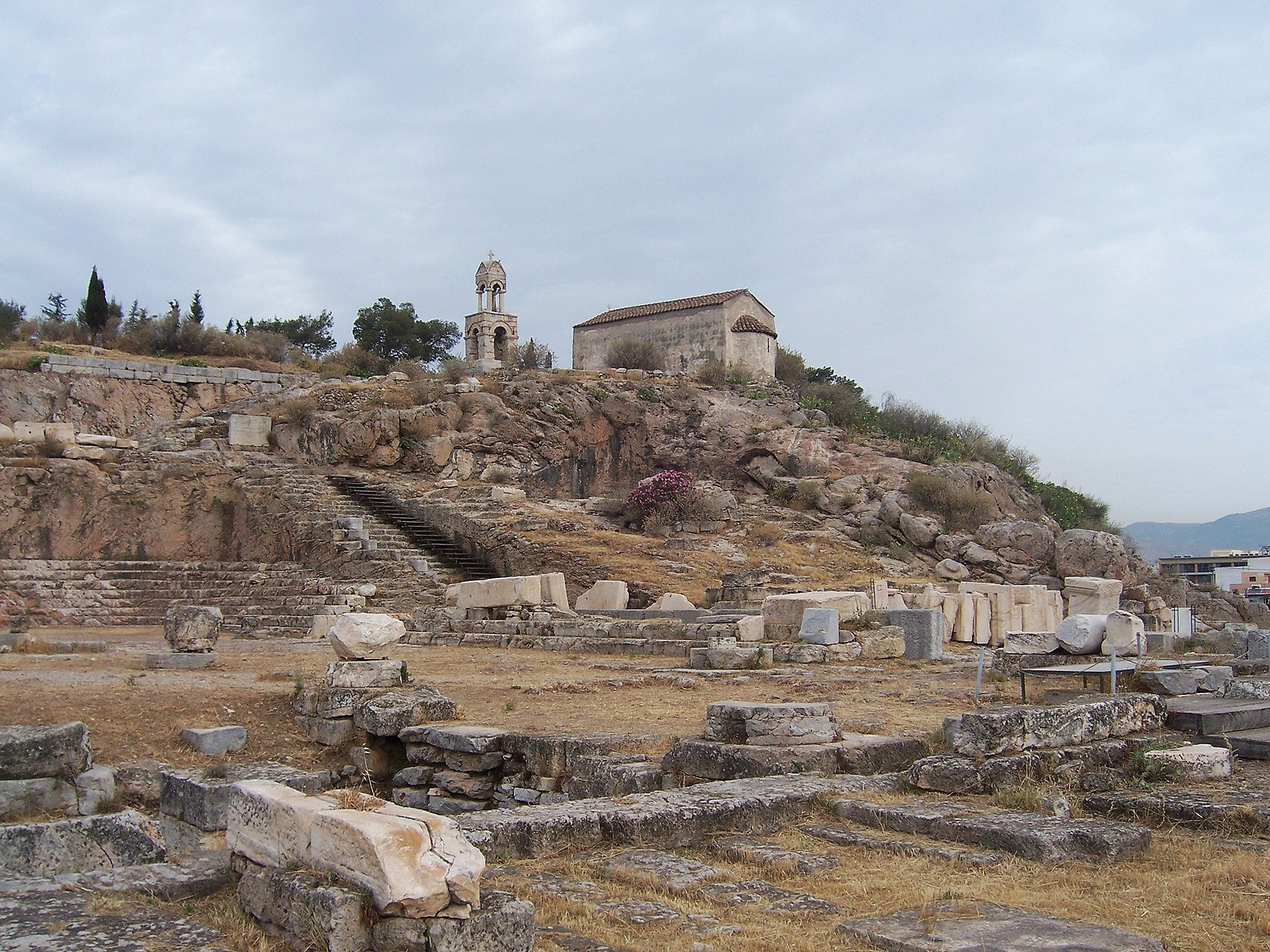
By Carole Raddato from FRANKFURT, Germany - General view of sanctuary of Demeter and Kore and the Telesterion (Initiation Hall), center for the Eleusinian Mysteries, Eleusis Uploaded by Marcus Cyron, CC BY-SA 2.0
- Site plan

